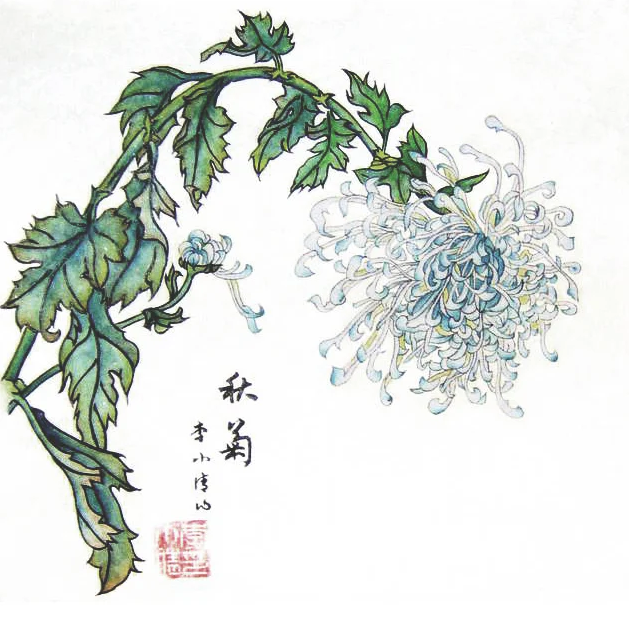
Chinese painting (中国画 Zhōngguó huà) is the traditional pictorial art practiced in China for over a thousand years. Its roots draw from an even older original thought that emphasizes the unity of man and the cosmos, as well as the uninterrupted dynamism of the universe itself. More than the representation of a form, Chinese painting seeks to express the soul (principle of life), the internal movement of beings.
In general, Chinese painting consists of one or more poems (诗 shī), calligraphies (书法 shūfǎ), a painted image, and the artist's seal (印章 yìnzhāng). Various methods must be distinguished:
- The Chinese Gongbi painting (工笔 gōngbǐ, lit. "The careful brush" or "The skillful brush") is distinguished by its fineness and precision in detail.
- The Chinese Baimiao painting (白描 báimiáo, lit. "Line drawing") only draws the outlines in black ink. It is related to Gongbi (工笔).
- The Chinese Mogu painting (没骨 mògǔ, lit. "Without bones") resembles Gongbi (工笔), but, unlike it, it does not draw the outlines.
- The Chinese Xieyi painting (写意 xiěyì, lit. "Write the idea" or "Write the intention") is characterized by a bold stroke and mainly uses the principle of gradations.
- Chinese Shuimo painting (水墨 shuǐmò, lit. "Ink and water") is a style of Xieyi (写意), but is created only with black ink, playing with the nuances.
- And many others that are generally variants of the styles already mentioned.
The goal of Chinese painting is to create, with the greatest conciseness, a work of artistic charm that carries a meaning that touches the infinite. Indeed, in traditional Chinese thought, the universe is composed of breaths (气 qì) of various densities and always in motion, the very source of life. Recreating these breaths in an image gives it life and establishes a direct link between the universe, the painting, and man. Thus, the act of painting or contemplating a painting allows one to rediscover the unity, often lost, with the cosmos. In this, Chinese painting is more of a way of life than a simple aesthetic work. "Rhythm of Qi and Vital Movements" is an excellent expression to grasp the meaning of Chinese painting.
The formats used in Chinese painting are very varied. The most well-known are "the large scroll" (大轴 dàzhóu), "the horizontal format" (横幅 héngfú), "the fan" (扇面 shànmiàn), etc.
Human figures (人物 rénwù), landscapes (山水 shānshuǐ), flowers and birds (花鸟 huāniǎo), mammals (走兽 zǒushòu), insects and fish (虫鱼 chóngyú), architecture (建筑 jiànzhù), etc., are the subjects. The sources of inspiration are thus found directly in nature, but also in the paintings of the ancient masters.
Landscapes (山水 shānshuǐ), human figures (人物 rénwù), and flowers and birds (花鸟 huāniǎo) are the three favorite themes of Chinese painters. This implies an in-depth study of plants and flowers according to the four seasons, as well as that of the physiology of birds, insects, fish, and mammals. One must also develop one's sense of observation while keeping in mind traditional thought to perceive dynamism through an apparently static landscape.
The essential points of the composition of Chinese paintings are:
- General organization and directions (ascending, descending, slanted, etc.).
- Density and grouping (or dispersion). The ancients used this expression to give an image of the density of a painting: "Spaced so that a horse can cross, dense so that not even the wind can penetrate."
- The void (空 kōng). In traditional Chinese painting, the void holds a very important place. It can represent the sky (天 tiān), the earth (地 dì), water (水 shuǐ), clouds (云 yún), etc. It allows for the image in the painting, but also to project the viewer into a much larger, even infinite, world by giving free rein to the imagination. Contemplation is based on the "full" part of the painting as a springboard to propel itself into the absolute through the "void" part. Chinese poems rely on the same principle.
- Even more important are the inscriptions (题字 tízì). They include the title, the content (poem, prose, description, story, etc.), the author's name and seal. Everything must be calligraphed in different styles according to what the artist wants to express. The choice of inscriptions and their positions depends on the life of the painting. They complete the work. Without them, Chinese painting is just a body without a soul.
